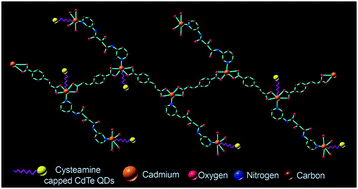A MOF functionalized with CdTe quantum dots as an efficient white light emitting phosphor material for applications in displays†
Abstract
Metal Organic Frameworks (MOFs) are known to be good luminescent materials in the narrow range of visible light. On the other hand, quantum dots (QDs) have high extinction coefficient, broad absorption range and high quantum yield. Although intensive research has been carried out on white light emitting phosphor materials, the field remains totally unexplored in terms of achieving intense white light emission by integrating QDs with MOFs. Here, a Cd based MOF (CP1) has been synthesized, and the coordination sites of the Cd centres are made vacant by eliminating the coordinated methanol and water molecule through heating. Yellow light emitting CdTe QDs are then synthesized by means of proper functionalization and attached to the vacant site of blue light emitting CP1 to give intense white light emission with a CIE index of (0.33,0.32) at 330 nm excitation wavelength. The blue emission of pristine CP1 mainly arises due to the π–π* transition which undergoes a bathochromic shift after attachment to CdTe QDs. The QDs, emitting yellow colour, also show a hypsochromic shift and couple with the emission of CP1 to give white light. From cyclic voltammetry (CV) measurements, it is observed that the individual band alignments get altered after attachment, creating an opportunity for energy transfer from the Highest Occupied Molecular Orbital (HOMO) of the QDs to the Lowest Unoccupied Molecular Orbital (LUMO) of CP1. This is further supported by the lifetime decay measurements. A device is also fabricated to measure the photo conductive property which shows as high as 64.3% change in the current value in the presence of photons, making it a potential material for light harvesting systems.



 Please wait while we load your content...
Please wait while we load your content...